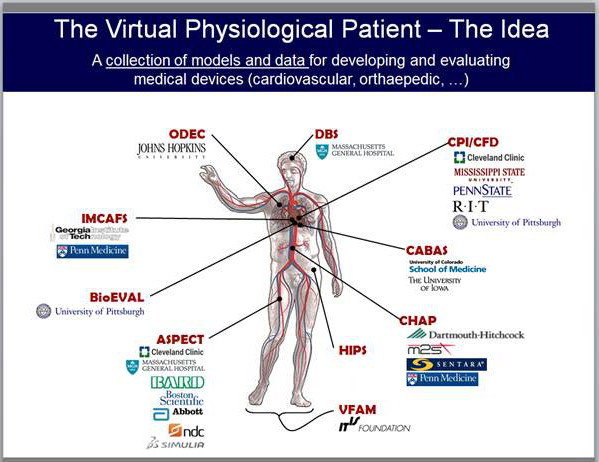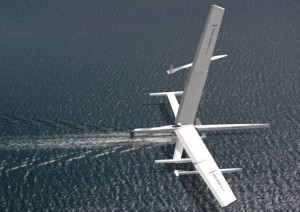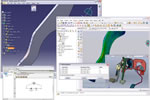
It’s no surprise that simulation is becoming more mainstream. Advances in technology, plus better integration with CAD software make that a foregone conclusion.
The United States Food and Drug Administration (FDA) has been seeing an increased number of submissions accompanied by simulation data. That sounds good on its face, but what if the simulation data is faulty, or unreliable?
The FDA is tacking that problem now, by reaching out to both the medical and software industries to establish guidelines for simulation, and by building a publicly available “Virtual Physological Patient.”
Cheryl Liu, a life sciences specialist with Dassault Systemes SIMULIA group, worked with the FDA to develop the following article about the FDA’s efforts. I don’t often merely reprint articles here, but I think this one has a special value, in helping to put context to the importance of simulation for medical devices. My thanks to Dassault Systemes for sharing it with me, so I could share it with you.
Simulation Now Recognized by FDA
as Essential to Medical Device Evaluation
by Cheryl Liu, Life Sciences Senior Product Experience Technical Specialist,
Dassault Systèmes SIMULIA
One of the toughest design engineering challenges is making a medical device that works flawlessly with the human body. The unique anatomy and physiology of every patient create physical complexities, and ever-shifting functional parameters, that must be thoroughly accounted for when producing a therapeutic product that may need to last a lifetime.
Domestic inpatient procedures involving medical devices—stents, heart valves, dental implants, spine and joint implants, surgical tools, blood pump, endovascular grafts, drug-eluting devices and more—totaled 46 million in the U.S. alone in 2006, according to the Centers for Disease Control (CDC). It’s a global market that is growing along with aging populations everywhere.
Computer simulation, already widely accepted in many industries, is increasingly being viewed as an important tool by medical device companies and their designers. It helps them visualize what they cannot see, explore the design space more fully, refine their ideas faster and more accurately—and reduce expensive prototyping and testing.
Solid mechanics simulations can help determine proper implant size, evaluate manufacturing tolerances, compare design geometries or consider next-gen devices. Fluid dynamics can be employed to identify high-shear stresses on blood vessels, regions of low flow, and potential for blood damage. And simulation-based product development processes can be linked in automated workflows, optimizing huge quantities of design data to provide exquisitely fine-tuned results that are of particular value for creating patient-specific medical devices.
FDA sees increasing numbers of applications that include simulation
As Life Sciences engineers embrace simulation, they are achieving increasingly accurate levels of precision when evaluating device function, including the ability to evaluate aspects of device performance not possible with bench tests alone. As a result, the Food and Drug Administration’s (FDA) Center for Device and Radiological Health (CDRH) is seeing a growing number of submissions for medical devices that include a simulation-data component.
The CDRH is responsible for regulating firms that manufacture, repackage, re-label, and/or import medical devices sold in the U.S. The submissions for these therapeutic devices typically contain data from four types of evaluation models—animal, bench, computational and human—to demonstrate a reasonable assurance of safety and effectiveness. When a company submits simulation metrics that supplement bench testing, this can help promote approval by demonstrating both the integrity of the proposed device and the required realistic device failure analysis. As the ultimate safety-and-effectiveness regulatory body between medical device manufacturers and patients, the FDA recognizes the value of such advancing technologies—and its own need to stay abreast of them—and has now begun actively encouraging the use of simulation in device evaluation.
However, the FDA has also put the industry on notice that verification and validation must go hand-in-hand with the use of simulation in applications. The CDRH is looking to quantify when a computational model is credible enough, and what its intended purpose is appropriate for a regulatory submission. Unclear reporting standards, insufficient data about geometries and boundary conditions, lack of validation metrics, incomplete understanding of physiological loads in the body, and variations in patient populations—any and all of these uncertainties can impact the relevance of simulation outputs.
SIMULIA contributes to advancement of knowledge
Noticing that a significant proportion of the applications they have seen in recent years have included simulations with Abaqus finite element analysis (FEA) from Dassault Systèmes SIMULIA, the CDRH reached out to us in 2010 for support in developing their own internal framework, and in-house expertise, for validating and regulating industry-submitted simulations.
SIMULIA presented at the FDA’s 3rd workshop on Computational Modeling of Medical Devices the same year. We continue to deliver on-site training courses to FDA reviewers about best practices in modeling and simulation and to partner with the FDA on aortic valve model development (Image 1). The FDA has also presented at our SIMULIA Community Conference and Regional User Meetings. Realizing the importance of model verification and validation (V&V), in early 2011, ASME and FDA launched the V&V 40 subcommittee to develop V&V guidelines for the medical device industry specifically; we are actively participating, along with others in the industry and software communities.
As one outcome of these efforts, the FDA will publish a guidance document titled “Reporting Computational Modeling Studies in Medical Device Regulatory Submissions” in 2013. Appendices will cover fluid and mass transport, solid mechanics, electromagnetism, control loops, thermal transport, and ultrasound. Publication date updates can be found on the CDRH website at http://www.fda.gov/MedicalDevices/DeviceRegulationandGuidance/GuidanceDocuments/default.htm
The ‘Virtual Patient’ idea is born
As knowledge about the importance of simulation grows, another priority for the FDA is the creation of a publicly available ‘Virtual Physiological Patient’ of human body computer models in different disease states (Image 2). This is not intended to be a single model encompassing every function and disease at once. Rather, the project will comprise a library of verified and validated submodels and data based on the combined expertise of those groups in the relevant disciplines, i.e., cardiology, orthopedics, software and so forth.

The goal of the Virtual Physiological Patient project is a shared point of reference that will improve understanding of model attributes and limitations, and provide discrete models, data and simulations validated for regulatory evaluation. Peer review by experts in academic, government, and industry will ensure robust V&V and provide periodic assessment. SIMULIA is contributing expertise to a group that is developing a computational model for the evaluation of a diseased femoral artery for stent evaluation.
Newly Launched Public-Private Partnership will benefit all parties
Concurrent with the development of the Virtual Physiological Patient concept, the FDA is reaching outward to device manufacturers, software providers, and medical professionals to form a Regulatory Science Public-Private Partnership. Launched in December of 2012, the partnership is called the Medical Device Innovation Consortium (MDIC). Specific details are available at http://www.deviceconsortium.org/ .
The idea is to create an opportunity for information gathering in a pre-competitive state, i.e., not device-specific, but disease-specific. For example, if the heart valve community were interested in a comprehensive evaluation of the structure and function of heart valves, costs could be minimized through non-profit group funding and participation in the development of tools and resources for modeling and simulating of a range of valves. All results would be shared. End-stage renal disease is another area recently identified by the FDA as a priority. Industry forums on this topic are already underway.
The medical device industry can only benefit from such endeavors. Individual device design copyrights certainly need to be protected, but the tradition of publishing evidence-based research results in order to move the entire body of medical knowledge forward has resonated in the Life Sciences throughout the history of medicine. A deep understanding of the function of the living body is critical to every medical-device developer, and sharing the data that lie at the core of that understanding can be accomplished without infringing on any one company’s patents.
The FDA views modeling and simulation as incentives to innovation that can reduce the time and cost of device design, assessment, and manufacturing. It is in all our interests—the medical device industry, the regulatory agency, and software companies—to collaborate to ensure that the power of simulation is increasingly utilized to solve the wide range of challenges in medical device development. We can all agree that the ultimate goal is the safety and effectiveness of medical devices for every physician who uses them, and every patient who needs them.
Special thanks to Dr. Tina Morrison, Dr. Nandini Duraiswamy and Dr. Donna Lochner of the FDA for their assistance in preparing this article.
For More Information: www.fda.gov
Read more about how the FDA is promoting innovation in “High Stakes Balancing Act” in COMPASS magazine www.compassmag.3ds.com.




